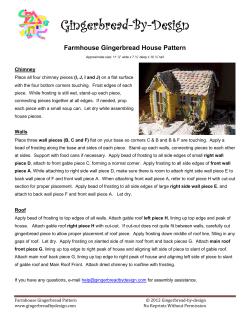
Document 180191
Few home renovationsrival a new skylight for impact. Here's how to let in the rays BY ALLAN BRITNELL ND THE LORD SAID, "Let there be light." Or was that your spouse? For Barb and George Hourtovenko of Hamilton, Ont., the question came from within. They wanted a skylight to help brighten up their kitchen, which received little natural light from a window facing east into a neighbour's exterior wall. For this job, we spent two days at their home while Denis Charron and Ed Milloy of Toronto"'based Skylights Unlimited installed a double skylight over the kitchen. Their tips and the accompanying photos will help you in your DIY installation, but you should always use the instructions that come with the skylight you buy as your main reference guide. You can also ask the skylight dealer for an installation video; some manufacturers make them available for DIYers. Skylight installation is a two-person job. A lot of the work requires two sets of hands and it's safer to work with a helper. The job calls for many standard tools, but you'll also need a few specialty tools. A reciprocating saw is ideal for cutting rafters and d~all. A scaffold will make life easier, not to mention safer. Gloves, dustmask and goggles will make working in the attic more bearable. You'll also need a bevel, chalk line and a prybar. Your first step in a skylight installation is to determine where you want to-and more importantly, where you caninstall the skylight. It's not an exact science. Factors like the placement of beams and rafters, wiring and plumbing and the location of roof vents will influence where. your skylight goes. You should also consider installing the skylight on a north or east-facing slope to avoid direct sunlight into the house, which will make it hot in the summer and fade carpets and furniture. For an overview of the types of skylights and accessories you can buy, see page 38. 32 CANADIAN HOME WORKSHOP JULY/AUGUST 1998 .. >= ~ OJ ~ 0 ~ >= ~ .. .. ~ ~ 0 .. 0 ~ .. JULY /AUGUST 1998 CANADIANHOMEWORKSHOP33 1. DETERMINE YOUR LAYOUT. Youneedto start by get- need to cut the joists. Cut them back 3" from the ting into your attic. After assessingphysicallimita- edge of the drywallto allow room for headers. tions around your preferred site, consider interior 7. BUILDHEADERS. Build doubled-upheadersof the andexterioresthetics.Onceyouthinkyou'vefound I samesizestockasyourjoistsallthewayaroundthe a goodspot, start clearinginsulationand laying: opening. thingsout. Youmayfind it easierto workfrom a : 8. CUT THE RAFTERS. Build temporary supports piece of plywood laid securelyacrossseveraljoists. Start by layingout the exteriorroof opening.Youcan I around your rafters beforeyou cut them. "A lot of the wood you remove can be reusedfor the headers," I I I I cut an observationhole in the roof to help you with: says Charron."In fact, I preferto use it becauseit's the layout.Tryto place the skylight betweenexisting: rafters if you can. Anythat are cut will haveto be sup- already dried and won't warp." Not to mention sav- : ported while you work. Never cut trusses or more: and cuts to the rafters you need to build a frame of . I aye ~ ~ h e wo mg some moneyand a tree. To support the skylight doubJedup 2' x 6' all the way around your exterior 0 d roofasyou~idon the interiorc~iling(seephoto11 for a goodviewofthe newframing).Securethecornerswithjoisthangerbrackets. Atthispointyoucan cut out the roofandstart installingthe skylightor - rom you can work on the tunnel. I than two rafters without consultinga building engi- alr,~:~;~_1' dried I I '-' neerfirst. Onceyou'vedeterminedyour spot on the: exteriorroof, do the same on the ceiling. You'llwant: to flare the tunnel walls to allow for as much light as : possible."Thesize of the openingwill really depend: on what the framing will allow, how deep the tunnel I and won't warp I I will be and also a bit of commonsense,"saysCharron. A 2' x 2' skylight would be dwarfed in a 8' x 8' opening. Two to three times the skylight size is a good standard for the opening. Use a level held: againstthe inside of each end rafter to mark a point : : : 9. FLARETHETUNNEL.If you have a cathedral ceiling you can skip the difficult and time-consumingjob of building a tunnel. For those less fortunate, it's time to hunt down a bevel-a small tool for measuring and I transferring angles. "If you take your time and make I I on top of the ceiling. Drive a nail in each corner- : inside ofthehouse. : 2. RUNA CHALK LINE.Usethe nails as guidesto run: a chalk line alongthe ceiling. 3. BUILDA SCAFFOLD. Youcan workfrom laddersbut light and the opening will determine the angle of your tunnel. Use a level and bevel to determine the I I I angles so you can cut studs for the tunnel walls. I Charron suggests that you try to split the angle even- I it's much safer and easier to work from a scaffold- sure everything is square you'll save yourself a lot of time in the long run," says Milloy. The size of your sky- these will showwherethe tunnel edgeswill be on the: : ly between the top and bottom walls to make for eas- ing-you can make your own like Charronand Milloy: ier layout and drywalling. did, or you can rent one. Setting up a tarp to keep: 10. INSTALLA CROSSPIECE. Nail a crosspiece across the insulation and sawdust contained is a gOOd: the length of the tunnel. "We do that so you have an I idea. Here Milloy tacks up a tarp from the ceiling to I even level for the drywall to taper down from. OtherI the base of the scaffold. It contains blown insulation: and drywall dust and makesclean-upa lot easier. 4.CUTYOUROPENING. Onceyour scaffold is secure, it's time to cut the drywall alongyour chalk line with I :: ::I I I I the reciprocatingsaw.Makesureall wiresin the attic are safely out of the way beforeyou begin. If all goes well it should come down in sheets. "I use a dull blade and keepthe cuts very shallowso that I don't I wise, with two different angles you'll have to bend the drywall. And that's a situation the averageDIVer doesn't want to get into," explains Charron. Toenail studs about 16" apart from this piece into your headers. If you're thinking of installing lights in the I : : tunnel itself, as the Hourtovenkos did, this is a good time to install the light boxes and run any new wiring : that will be needed. I cut any wires or joists," says Milloy. I 11. READY TO CUT. Weather permitting, it's time to I 5. TAKEDOWN THEDRYWALL. Haveyour partner up in the attic to makesureyourcuts don't go astray.From there they can also help give some leverageon the drywall once it's cut. 6. CUTTHEJOISTS. Once your ceiling is open you'll I cut a hole in your roof. From the attic drive a nail up I : : : : through the roof in a corner of the header. From the roof use this nail to figure out the area of shingles to remove.If it's in the top right corner,removeshinges below and to the left of it. ILV/AUGUST 1998 CANADIANHOMEWORKSHOP35 36 CANADIAN HOME WORKSHOP JULY/AUGUST 1998 12. REMOVETHE SHINGLES.Timing is a key part of skylight planning. Installing a double skylight-a popular option since you get added light with little: extrawork required-will take morethan a day to fin- : that the drywallwill fit evenlyinto the channelall of I the way around the window. When drywalling, you I I may need to shim the studs to the gyproc. : 17. SCREW IT DOWN. Once the skylight is centred, ish. You probably don't want to put a hole in your roof: screw the skylight through the roof sheathing and if the skies look overcast. Temperatur~ will playa: into the headers using all the hardware provided. part too. Don't removeshingleson an extremelycold: day or they will crack. Extremeheat can makework- 18. ICE ANDWATERSHIELD.Now you'll want to install I an impermeable ice and water shield all the way I I ing on the roof unbearable. If you're set, put on your: around the skylight (see page 38). Start from the bottom and work your way to the top to create an sunscreen and head outside. "There should be a rule: that you nevergo on your roof without havingsome- : overlapping one with you," advises Milloy. "It's good to have Wl th the skyl1 8 waterproof barrier. It goes up most of the side of the skylight and under the layer of shingles. "This stuff bonds like crazy. Once the sun hits 8 gh it,nothingwiligetitoff,"SaYSCharron.Fortiler~ofs or other uneven surfaces, you'll need to get a flexible lead apron. When you install the flashing, also work- I , :: ..1 someone around if something goes wrong." Use a prybaror cat's pawto pop the nails up without dam- ingfromthebottomonup,besureyounailit intothe skyli~htframeonly,andnotintothe roofingboards. : : - aging the shingles. In order to avoid mismatched: shingle colours around your skylight, you'll need to : I reusesome of them shortly. Havesome spare shin- I I gles handyjust in case you can't get any of them off I Letit rain I without cracking. 13. ANOTHER CHALKUNE.Get your partner to drive: up more nails from all the inside cornersof the window opening (since there were two windows in this case,Charrondroveeight nailsinto the corners). : Startwith the bottom piece and then work your way : the flashing, overlap with a shingle and attach up the side with L-shapedstep flashing-lay down I I I I I another flashing piece. Make sure you don't nail through the flashing when reattachingthe shingles. 19. INSTAUFLASHING CAPS.Whenall the flashing is Use these nails as a guide to mark a chalk line for: cutting theroof. : on, reattach the flashing caps following the manu- 14. CUTITOUT.If you'refeelinghardcore,you can cut I I facturer's instructions. Use roofingtar (the kind you the openingout from the inside with a reciprocating: saw. Otherwise,follow your chalk line with a circular I saw. Have your partner positioned below to catch the buy in a caulking tube is easiest to work with) and roofing nails to reattachthe shingles. 20. A FINISHED EXTERIOR. With the skylight in, the I I I I pieces.Takethem inside or throw them off the roof: water shield down, the flashing and shingles immediately.A gustof wind can easilythrow plywood: installed,you'vefinished the outdoor part of the job. Let it rain (if it must). Once you've cleaned up, it's through a window,or it can knockyou off the roof. 15. NAIL DOWN THEROORNG BOARDS. Onceyou've cut out the hole for the windowsome of the sheathing will need to be refastened. Nail the roofing boards around the edge of the opening into your headers. Rememberto watch your step, it's a long way down to the kitchen. 16. CENTRE THEWINDOW. Takethe flashing caps off the skylightand then sit it overthe opening.With one I timeto movebackinsideforthefinishingtouches. I I I 21. INSULATE : : : I I I I I : THETUNNEL. Properinsulation of the tunnel is key to a successfuljob. Wearinggoggles and gloves,levelout any insulationyou movedin the ceiling. Use R-20 insulation (it meetscode for walls and fits nicely betweenthe studs) and seal it with a vapour barrier. 22. IT'S DRYWALL nME. Drywallingcan be a tricky personoutside and the other inside, centrethe sky- job, especiallywhenyou'redealingwith angledwalls light in the hole. The window Charron and Milloy six feet over your kitchen floor. If you're owed any favoursfrom your buddythe drywaller,this might be installed, manufactured by Velux, comes with a channel into which the drywall fits (see "Skylight, Skybright,. page 38). Grab a small scrap of drywall. If you'vecut your openingto the right sizethe person on the inside should be able to fit the drywall along the channel on all four sides. Adjust the windowso I I : : : the timeto cashthemin. (Formoreinformation on drywalling,see the February1992issue.)Oncethe tape is is dry and sanded,a couple of coats of paint, preferablya light colour to reflect the sunlight, will : finishthejob off. lillY/AUGUST 1998 CANADIAN HOME WORKSHOP 37 about $400. at high condensation areas you'll want, at the very least, a venting skylight. A bare bones 2' x 4' fixed skylight costs about $200. The same size skylight that opens can cost $500 or more. If you've been planning on adding a room in the attic or above the garage, you might consider roof windows,which are essentially operable skylights within reach. Since they tilt open they can be used as emergency exits. start decided windows THE HOURTOVENKOS to install a skylight in their kitchen, they wanted the most impact for the fewest dollars. They decided against expensive operating skylights (those that can open up), because an existing window provides most of the ventilation. But for extra ventilation up high, they chose a skylight with a small operable rainproof vent. More significantly, they opted for two sideby-side skylights for maximum light. Double skylights are a growing trend: if you're up there framing anyway, why not put in another one? It doesn't take much more time, and the chief incremental cost is the extra skylight, which may be as low as $200. nSomepeoplealso think singleskylight shafts have a coffin-like appearance," notes Terry Blondin of Velux-Canada Inc., a Montreal-based skylight distributor. Skylight prices vary depending on size and whether it's fixed (i.e., it doesn't open), operating or has other features like vents. If you're installing a skylight in the bathroom or other Roof WHEN THISSKYLIGHT featuresan smalloperablevent,a Thereare other coststo drywallchanneland staggeredbracketsto allowthe consider. For each skylight side-by-side installationof multipleskylights you install you'll need to buy the corresponding flashing kit. endure Canadian weather. You can These range from $70 to $100. You buy a packagethat will be enough to will also need an additional connecdo one window for around $20, or tor kit for any side-by-side skylight pick up a 200 sq. ft. roll for $80. If you have a roof with little or no installations. The ice and water shield is a necespitch, you'll need to install a roof curb sity for skylights that will have to that anglesthe skylight by at least 150 so it will shed water. As with cars, you can buy a base skylight model, or you can add bells and whistles and drive up the price. You can buy a manually operated rod to open your out-of-anl1~$,.reach win. 0, dows for $ 50, the mott')rized rod for $200 or skip rods altogether and get the motorized window attachments for $650 or more. If you still have money to burn (and tend to leave windows open when you go out), add Chancesareyou'regoingto be a $70 sensorthat will dose the skylight taking down a light whenyou I when it sniffs rain. install a skylight.No problem, Another factor that will affect except when the sun sets at I your final cost is how the skylight is night. To prevent stumbling i made. Do you go with an acrylic aroundin the dark,you'll prob- , dome-shaped skylight, or do you opt ablyneedto installnewlights. ' for a sealedunit with 10w-Eglassand There are a couple of argon gas?Low-E is a low emissivity options.Youcaninstalltrack I coating that traps heat in the winter lightsor pot lights aroundthe and blocks out heat in the summer. skylight opening. Or you can I_Argon is an inert gas that acts as an do what the Hourtovenkos THE EXISTINGLIGHT(phototop left) wasremoved insulating barrier between the windid and install lights right in before the ceiling wascut out for the skylight dow panes. Low-E and argon gasadd thetunnel. Beforethe drywall shaft. The homeowners installed new pot lights in to the price, but they are pretty much goesup it's easyto install pot the shaft before the drywall went up (above) becoming standard with all windows lights in the tunnel studs. If these days. you'veremoveda light, you mightbe ableto usethe wiringfrom it. Otherwise,you'll have And don't forget the customized to install newwiring. Whenin doubt, hire an expert. blinds at $75 to $400 a set. G I I 38 CANADIAN HOME WORKSHOP\lU IGUST 1998
© Copyright 2025











